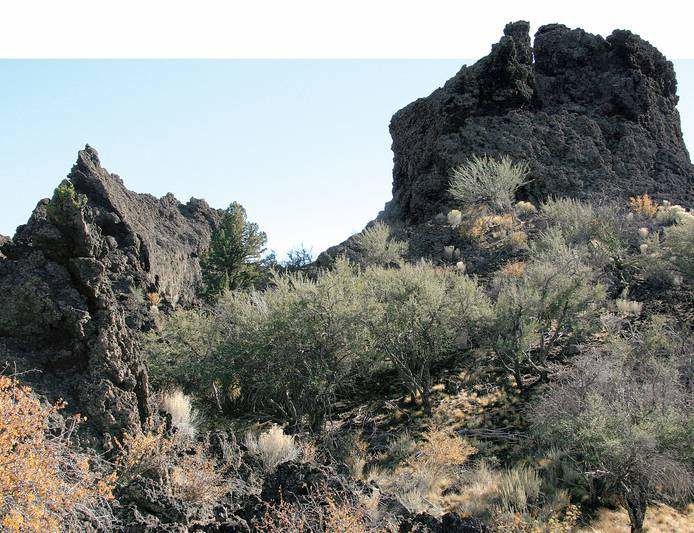Imagination grows at Devil’s Garden
Published 5:00 am Wednesday, October 17, 2007

- This jumble of volcanic debris offers an interesting contrast to the landscape on the edge of Devils Garden. Bighorn sheep like the rough lava terrain the more rugged, the better.
We marveled more than once over the extent of wide open spaces in the area known as Oregon’s Outback.
We were ultimately headed for the vicinity of Devil’s Garden, a High Desert tableau of crumbly burnt-brownie lava and the usual flora: juniper, ponderosa pine and sagebrush. One highlight is a hodgepodge slope of volcanic debris, known as the blowout, on the eastern edge of Devil’s Garden. It’s a cone that once spat lava over the surrounding countryside. What’s left is a hillside of irregular lava boulders and rocks that provides a nice vantage for those sure-footed enough to reach a high spot. Be careful, as the lava is sharp, the footing is treacherous and gravity is gravity no matter where you go.
Despite the volcanic underpinnings and demonic name, Devil’s Garden is a pretty cool place. We were drawn by the possibility of a bighorn sheep sighting, but it wasn’t to be. Devil’s Garden is a roughly 45-square-mile lava field northeast of Fort Rock and southeast of China Hat butte. That’s lots of country, although I had no trouble picturing a majestic ram up near the top of the lava jumble in my mind’s eye.
But just knowing that bighorns are out there someplace is enough to fire the imagination and keep me coming back this way.
California bighorn sheep, originally found in the more arid regions of Oregon, including Steens Mountain, Hart Mountain and the Owyhee River Canyon, were exterminated by 1915 by over-hunting and livestock diseases. Rocky Mountain sheep, native to Hell’s Canyon and the Wallowa Mountains in northeastern Oregon, were wiped out in Oregon in the 1940s. But an aggressive reintroduction campaign has California and Rocky Mountain sheep posting a remarkable comeback in Oregon. The replacement stock came from herds in other states.
A small herd of California bighorns was introduced to the Devil’s Garden area more than a decade ago, followed by a few more small releases, according to Oregon Department of Fish and Wildlife biologist Stephen George.
He said the sheep in Devil’s Garden and out on the nearby East Lava Field are holding their own. But mountain lion predation has taken its toll, especially on the young sheep.
“We’re getting lots of juveniles, but getting them through their first year is pretty difficult,” George said.
Most of the bighorn sheep sightings in Devil’s Garden occur to the south, near Cougar Mountain, where the ewes and lambs seem to congregate.
“Generally, the more rugged, the better,” said George of the bighorn’s preferred habitat. “They’re out in the lava flow quite a bit.”
The “nasty terrain” can shred a pair of mid-weight hiking boots in an afternoon.
Despite an early start, we didn’t get to the Devil’s Garden area until mid-afternoon. We made a big circle, spending the morning moseying through Fort Rock and along several gravel roads in the area, taking in Cabin Lake and the Green Mountain Lookout (Forest Road 6109) before reaching our destination. During our leisurely journey, we saw all manner of raptors, a badger, eight mule deer does sticking close together and countless chipmunks. But, alas, no bighorns.
About a mile north of the blowout cone on Forest Road 23 is Derrick Cave, formed when a river of lava poured through the tube, then drained. According to the “Central Oregon Cave Book” by Charlie and Jo Larson, Derrick’s main entrance and skylights resulted from collapses after the lava had cleared the tube.
From the cave, it was a straight shot north to U.S. Highway 20 near Millican, and back to Bend.
If you go
Getting there: To reach Derrick Cave and the northeast edge of Devil’s Garden from Bend, drive east on U.S. Highway 20. About a mile past the Horse Ridge Summit and before the abandoned town of Millican, turn right on to Forest Road 23 toward Sand Spring. Forest Road 23 turns into a gravel road about six miles in; take the left fork. Forest Road 23 will take you all the way to the cone at Devil’s Garden, which is on the right about a mile past Derrick Cave. There’s a dirt pullout on the right side of the road, but the spot is otherwise unmarked. You can’t miss the hill of lava, however.
Contact: Bend-Fort Rock Ranger District of the Deschutes National Forest, 383-4000.






